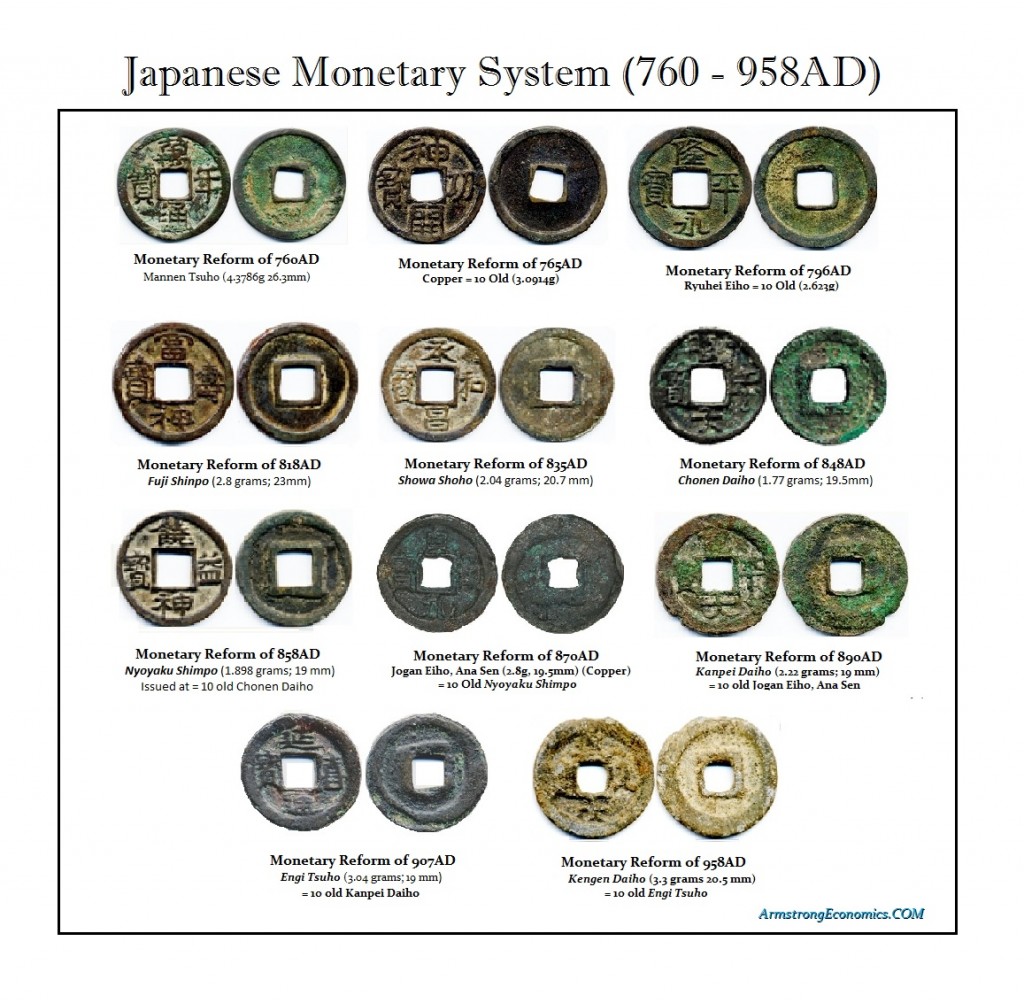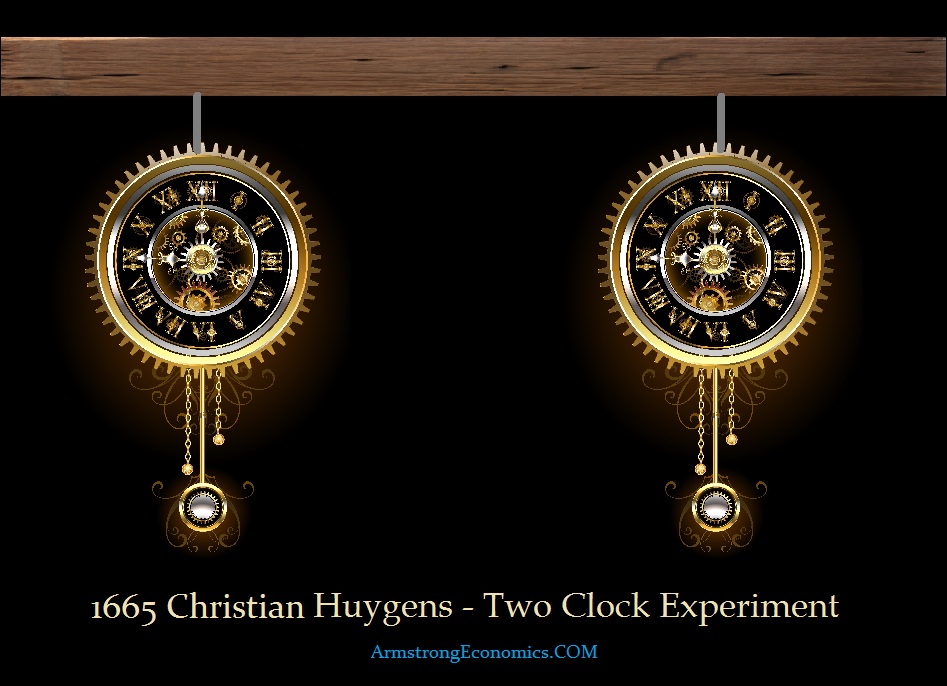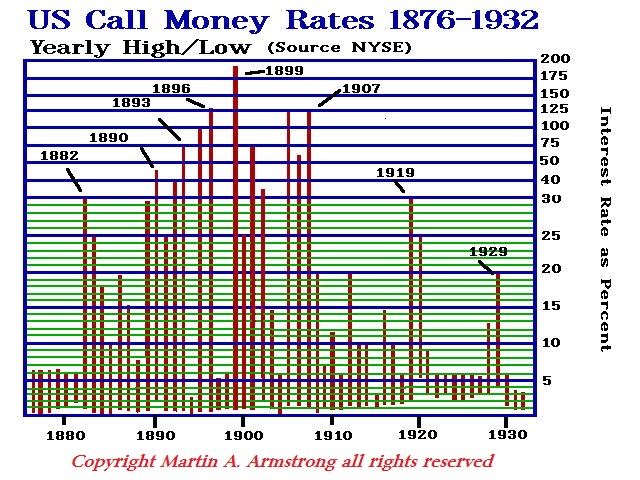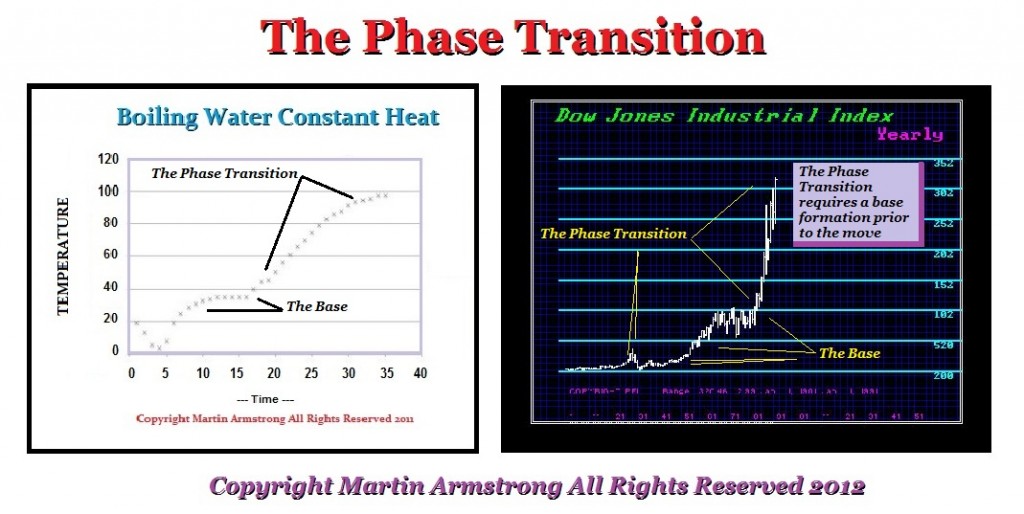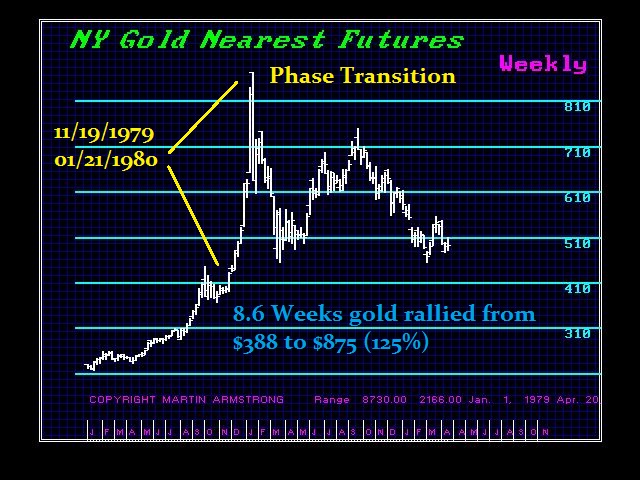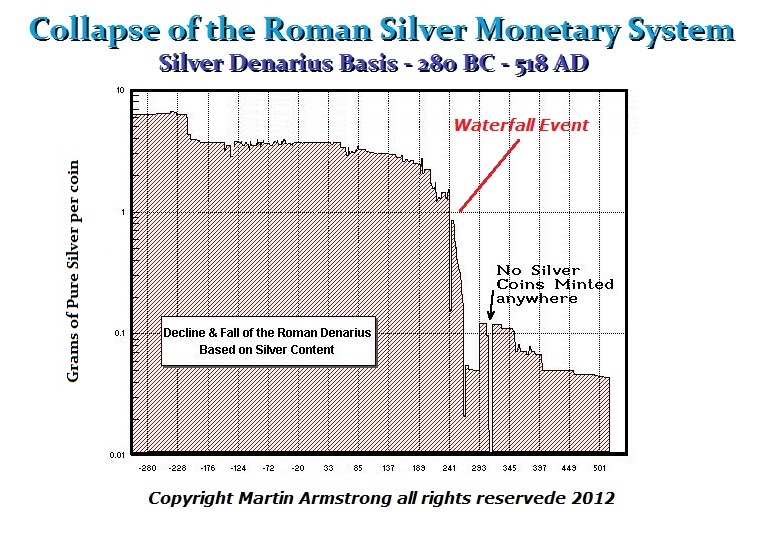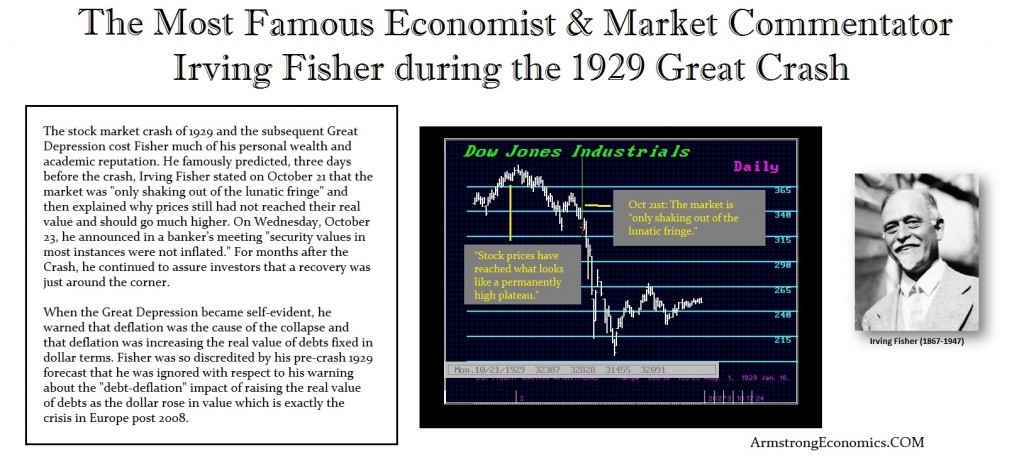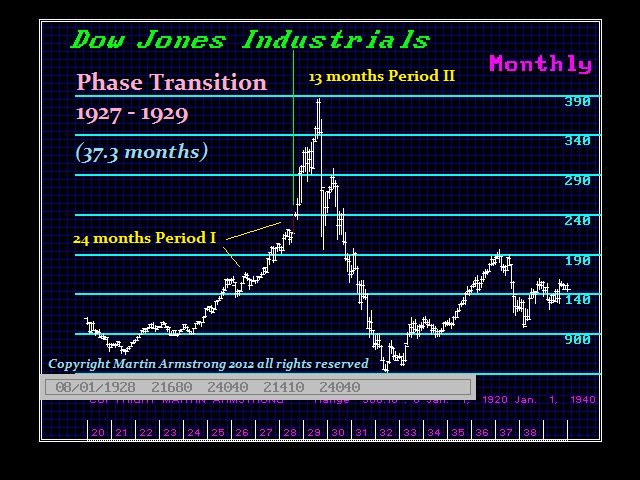There is an enigmatic power which is the true Mysterious Force of Synchronization which exists in everything within the universe from electronics, biology, all the way to planetary movement. This mysterious force is known to engineers and even the military. In 1831, there was a rather interesting collapse of the Broughton Suspension Bridge in Manchester, England. The bridge collapsed because of a mechanical resonance which was created by troops marching over the bridge in step. The constant rhythm of synchronization of the army walking in lock-step resulted in the collapse of the bridge. Civil Engineers must be mindful of the fact that a footbridge will become vulnerable at a specific frequency sort of like a singer breaking a glass. It is also commonly known that women living together within a few months end up find the syncing of menstrual cycles. There have been many theories that perhaps women’s pheromones interact when they are in close proximity, causing them to have their period at the same time.
Yet the Mysterious Force of Synchronization goes far beyond such interest events. In studying the world economy and interest rates, Japan was a very interesting study. Japan only entered the modern world in 1867, when the last Shogunate fell and political power, after a lapse of several centuries, returned to the emperor – Emperor Meiji (1852—1912). I have written about how the previous emperor abused their power to create money. As a result, the private sector simply refused to accept Japanese coins because with each new emperor he would devalue the coinage of the previous emperor to 10% of his new coins. That not only ended the hoarding of cash, but it led to people using commodities and Chinese coins for 600 years. Nevertheless, what I discovered was the fact that there coincided with Western culture the same boom and bust cycles. But it is important to keep in mind that speculation was not restricted to the West. In fact, speculation was also widespread in Japan, which had no financial connection with that of Western Europe or America until the Black Ships sailed into Japan in 1853. The shogun Yoshimune (1716–1745) banned all expensive clothing, furniture, cakes, candies, and other extravagances in an austerity decree in hopes of controlling inflation which appeared during the same time frame as the South Sea and Mississippi Bubbles of 1720.
These economic reforms were known as the Kyōhō Reforms which took place between July 1716 through April 1736 and were aimed at making the Tokugawa shogunate financially solvent during the same period as France in Europe which then turned to John Law. The reforms also sought to improve its political and social security of the government. There was a conflict between Confucian ideology and the harsh economic reality of the Yoshimune Shogun. Under Confucian idealogy money was defiling vs. yet it was a vital necessity for a cash economy. Yoshimune found it necessary to reject certain Confucian principles of austerity in the face of a serious economic crisis.
The Kyōhō Reforms were compelled to deal with frugality to end inflation and to create merchant guilds that allowed greater control and taxation. The ban on Western books, except those on Christianity, was lifted to encourage the import of Western knowledge and technology. This began the process which would be later accelerated by Emperor Meiji. What I discovered was that at the same period in time, there would be a worldwide economic boom and collapse between East and the West even before there was any regular contact. Even in ancient times, we see the revolution in Rome creating the Republic in 509BC and in Athens the overthrow of tyrants giving birth to Democracy by 508BC. This was not much different than Tiananmen Square April 15-June 4, 1989 in China which took place during February 1989, and the fall of the Berlin Wall by November 9, 1989 – nearly 8.6 months later.
The question which rises to the surface is rather straightforward. Is there a Mysterious Force of Synchronization or is this just coincidence?
In 1665, Christian Huygens (1629-1695) discovered this fascinating Mysterious Force of Synchronization observed that two identical pendulum clocks, weakly coupled through a heavy beam, soon synchronized with the same period and amplitude but with the two pendula swinging in opposite directions. This behavior is now called anti-phase synchronization. The fact that pairs of moving pendulums became synchronized as observed by the great Dutch scientist Huygens, still to this day have modern researchers scratching their heads
For physicists, synchronization is really intriguing in inert systems. Place two identical metronomes on a wooden bar mounted on two soda cans, and you’ll find that the rhythms of these mechanical devices will synchronize within minutes or even seconds. The question has been: How do the metronomes “decide” to reach a common rhythm? Indeed, why does this even happen?
 Huygens tackled one of the great problems of the era. Sailors had to navigate the ocean. To determine their latitude, they estimated the height of the Sun above the horizon and the angle its rays make with the Earth’s equator. However, they had no physical reference for determining their longitude – how far east or west their ship was at sea. To solve this “longitude problem” it required knowing the time difference between the local time (obtained from the Sun) and the “reference” time at the port from where the ship had set sail. Huygens was trying to create a pendulum clock that would provide a reliable and accurate time reference at sea.
Huygens tackled one of the great problems of the era. Sailors had to navigate the ocean. To determine their latitude, they estimated the height of the Sun above the horizon and the angle its rays make with the Earth’s equator. However, they had no physical reference for determining their longitude – how far east or west their ship was at sea. To solve this “longitude problem” it required knowing the time difference between the local time (obtained from the Sun) and the “reference” time at the port from where the ship had set sail. Huygens was trying to create a pendulum clock that would provide a reliable and accurate time reference at sea.
Huygens realized that it would take multiple clocks because if one stopped in rough seas, there was a backup. Huygens instructed that sailors were to use the time indicated by the clocks set to the time of the place of departure and then determine the local time based upon the position of the sun. If the time on the clocks was later than the local time, it meant the sailors were moving east yet if it was earlier, then they were heading west. For every hour of difference, this meant that there was a 15° of longitude equivalent.
Huygens set up an experiment with a ship setting sail from the island of St Thomas off the coast of Guinea in West Africa. They were able to find Cape Verde islands in the mid-Atlantic. Based on this successful trial, Huygens drafted a business plan and started to prepare his maritime pendulum clocks for sale. That is when Huygens discovered that was virtually impossible to build two identical pendulum clocks one would inevitably be slower than the other. If one of the clocks stopped, a four-minute difference would be a 1° error in the ship’s longitude.
This led to Huygen’s discovery of the Mysterious Force of Synchronization. Huygens was surprised to discover that if he hung two of his pendulum clocks from common support the devices kept pace relative to each other. The two pendulums always swung at the same frequency albeit in opposite directions to each other. What Huygens discovered was that the two pendulums would eventually synchronize. In a letter to the Belgian mathematician, dated February 22, 1665, Huygens referred to this odd phenomenon as “the sympathy of two clocks”. In another test, both clocks stopped in rough seas and the sailor failed to follow the instruction to restart them. Huygens realized that his idea would not work. Nevertheless, what he discovered was the Mysterious Force of Synchronization. This became known for the next 100 years as “Huygens synchronization” which they called in the Royal Society an “odd” phenomenon.
Huygen’s discovery of the Mysterious Force of Synchronization in pendulum clocks lacked the mathematical tools to explain the strange phenomenon. That required differential calculus which hadn’t been invented yet. The synchronization of Huygen’s clocks took place because of a transfer of energy to each other via the coupling bar. The mechanical vibrations are transferred and this results in synchronization. When the vibrations exerted by one pendulum clock on the coupling bar are exactly canceled by the vibrations exerted by the other they start to align. What is taking place is fascinating. Huygens’ clocks were influenced by the coupling strength, which is the ratio of the total mass of the pendulums to the total mass of the coupling bar from which the clocks were hanging. A large ratio indicates a strong interaction between the pendulums, whereas a small ratio corresponds to the weak interaction. Furthermore, for a small ratio, the pendulums synchronize with the opposite phase, whereas for a large ratio the pendulums exhibit a “beating death phenomenon”, in which one pendulum keeps oscillating whereas the other comes to a stop. This was the revelation discovered in 2002 by a team led by Kurt Wiesenfeld at Georgia Tech.
What Huygens discovered ends up revealing that there is a Mysterious Force of Synchronization phenomena that exists throughout the physical and the biological world around us. It turns out that right down to the moons that revolve around a planet are also displaying this synchronization. Here is an example of an audience clapping which by themselves eventually enter a phase transition and suddenly move from individual claps to a synchronized clap. Looking at the sound file, we can see the synchronization. Likewise, you are at a play, and everyone claps, but gradually they stop clapping and that too spreads through the crowd in synchronization.
This is a Phase Transition that unfolds in everything even in computer science. It is impossible to create even a random number generator ins programming for it will always return to a cycle. In economics, a Phase Transition is the culmination of a collapse in public confidence which manifests in a recession or depression. Central Banks lower interest rates trying to stimulate the economy by lowering the cost of borrowing. In 2014, the European Central Bank even went to negative rates in an effort to penalize people for hoarding their money and not spending. What they fail to grasp is that it is a matter of CONFIDENCE for people will pay 20% interest as long as they think they will make more than that from investment. But they will not pat 0.5% if they fear the economy will not recover and they may not be able to even make 0.5%. This is why the stock market has never peaked nor bottomed with the same level of interest rates twice. It is a non-linear complexity within a world economy that at the core functions as a Mysterious Force of Synchronization.
Unfortunately, in economics, they always create one-dimensional theories and assume the economy function like a bazaar in Baghdad where the seller and the buyer haggle and eventually come to an agreed-upon price which they often call “utility” within the economy. Besides the assumption behind traditional economy theories is “assuming all things remain equal” the economic theories of utility are equally false. Utility-based theories rest on the idea of a rational choice usually takes place that consumers will strive to maximize their utility in purchasing power. Economists have argued that the economic utility of a good or service is important to understand, because it directly influences the demand, and therefore price, of that good or service. As demand rises, so will the price. But the 1970s bout with STAGFLATION proved that assumption to be incorrect.
In truth, a consumer’s utility is impossible to measure and quantify because it is driven by a non-linear system. In the case of the 1970s STAGFLATION, prices rose as demand declined because the price was influenced by an external source being the OPEC price increases. Even those economists who argued that they can indirectly estimate what is the utility for an economic good or service would be by employing various models have failed because they never considered the complexity of the world economy.
Therefore, the cloak which masks the hidden order is effectively complexity which prevents people from understanding the world we live in because we are all connected. Politics prefers to present itself always as the solution to some trend domestically which is impossible to reverse any trend against that of the global trend for there is a complexity that involves global influences. The idea of an “economic utility” where the end value is determined like a bazaar in Bagdad, applies not on an individual level with respect to a specific good, by on a global scale whereby the trend in one nation will lead to the synchronization force impacting the world economy.

A Phase Transition is different. This is an explosive rally that emerges from a base that is akin to a spring. The tighter the spring is compressed, the greater the move to a new level. This is calculated mathematically by using the degree of energy that has been compressed. This is the basis of our Energy Models. When released, it simply explodes. This type of move often sucks everyone in and they expect it to be the norm.
Phase Transitions often alter the thinking of people so dramatically that they lose all reason. The Phase Transition in gold created the 1980 high on January 21, 1980, at $875, which unfolded in just 8.6 weeks. That simple brief period set in motion decades of people calling for the same thing over and over again. That brief Phase Transition convinced scores of people this was permanent and gold would soar to multiples of $1,000.
The collapse of Rome was also just 8.6 years. It is amazing how this frequency appears throughout history and has such a profound change to the upside or downside. We see the complete implosion of the Roman economy where the coinage was mostly silver to less than 2%. People hoarded money, so to pay the bills the only recourse was debasement. Taxes collapsed as did the economy just after the Emperor Valerian I was captured in 260 AD. By 268AD, his son Gallienus was assassinated and the coinage no longer resembled what existed pre-260 AD.
The Phase Transition in the Dow going into 1929 ruined the reputation of the leading economist and market commentator Irving Fisher (1867-1947). Three days before the high he announced, “Stock prices have reached what looks like a permanently high plateau.” The Phase Transition of the US share market into 1929 on a monthly level was 37.3 months (8.615 * 4.3). Likewise, on the weekly level, the overall final Phase Transition was also 13 weeks from 300.10 to 386.10. However, on the daily level, the final rally was a brief slingshot and from that low it was a 17.2-day rally (2 * 8.6) that created the major high at 386.10. Therefore, those final 17.2 days caused Fisher to proclaim a new permanent high level had been reached. This is the classic Phase Transition. Then, even as the market began to crash, precisely on the 34th day of that decline a temporary low formed which was four cycles of 8.6 days. He then announced that the market was “only shaking out of the lunatic fringe.” He coined a saying that has long since remained.
Thereafter, Fisher came to understand the mechanism that a rising currency increased the “real value” of debt and people could not service that debt, which resulted in a cascade of defaults. Nevertheless, the Phase Transition has a historical impact upon the thinking process of people. In Japan, it took 19 years to reverse that decline as it did in gold. In the case of the US stock market, it took 25 years to exceed that 1929 high. It was 19 years until 1948, which was the final fake low before the breakout rally truly began that was also 19 years. In the case of Europe, it appears it may also take until 2027 before any real life comes back into the economy once again.
Water takes a lot of energy to heat up. The amount of energy it takes to actually heat water is very well established. A calorie is the amount of energy it takes to heat one gram (1 mℓ) of water by 1°C. This can be expressed as 1 kcal = 4184 J, which is how much energy it takes to heat one kilogram (or liter) of water by 1°C. Therefore, 1 Btu = 1055 J, which is the amount of energy it takes to heat one pound of water by 1°F. Now, when we actually chart the progression of heating a pot of water, we discover a phase transition, meaning we are reaching the point when we convert the liquid water into a gas and see steam.
So if I want to take 500 mℓ of water from 18°C to boil, I need to expend 82×0.5 kcal to get the job done, or 171.6 kJ. It takes a lot of energy to boil a pot of water. The economy functions in the same manner. We progressively turn up the heat and then all of a sudden it enters a phase transition and erupts almost out of nowhere. This is the nonlinear progression of a boiling pot of water. Politics amounts to the same type of progressive curve.


